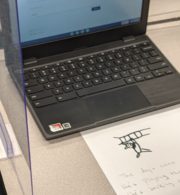
This week I led upper elementary aged students in a daily writing prompt activity. I facilitate this protocol often in classrooms grades 1 – 12 and have set specific supports in place to provide access for struggling learners. The prompt is open ended and therefore naturally differentiated for varied levels of writing. Reading is not a requirement for the activity, as students are to write a story about a picture placed on the board. The image sparks the imagination to address writer’s block. A timer placed next to the picture on the board supports executive processing and aids in time management. And both remote and in person learners are able to collaborate together on the activity, as students engage in a threaded discussion in Google Classroom regarding their writing.
While I have taken steps to universally design the activity, a new barrier arose as a teacher asked me, “What about the two students I have who can’t write?” In the past I have noticed teachers work with a student like this one on one, typing what the student dictates. But this time, I felt the need to find a way to empower the student toward more self-efficacy in the process. Additionally, the teacher wanted to support other students and not be tied to these two students for the entire lesson. I thought back to my time as a kindergarten teacher as well as the Universal Design for Learning guidelines. And I wondered aloud – what CAN the students do?

As seen in the image, one of the students drew a picture of her response, and then verbally told her story to a teacher. This teacher wrote the words she spoke under the picture, and she then copied this writing onto her chromebook into Google Classroom. A second student did the same. At one point he exclaimed, “Teacher, I already finished! I’m done with my writing!” The pride on his face revealed the positive impact of the activity. This student, identified as a “non-writer” had been given the tools to participate – to display his story to his classmates in Google Classroom. It is vital that we approach students with a strengths based rather than deficit model approach. Rather than asking, “what can’t they do?”, let us reframe our thinking to building upon student abilities.
Click here to view a video explaining the daily writing prompt protocol process.
